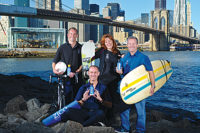A Team Sport
Sarah Theodore
Editor
Editor
The New York Giants’ surprise win over the New England Patriots in Super Bowl XLII last month, might have been one of the rare occasions when the on-field match-up proved as entertaining as the commercials. But that didn’t stop beverage industry advertisers from putting on a show as well. With 97.5 million viewers, the game was the most-watched Super Bowl event ever, and according to TiVo, five of the Top 10 most-watched ads during the game were beverage ads.
One of the expected competitions never really
surfaced, however. For the first time in nearly a decade, both Coca-Cola
and PepsiCo were running cola ads during the game, and some had predicted a
soft drink advertising showdown that would bring back the cola wars of
decades past.
The Coca-Cola Co. and PepsiCo did put significant
effort into advertising during the game. Coca-Cola ran ads focusing on its
“The Coke Side of Life” campaign, and Pepsi went back to its
tradition of using high-profile celebrities, this time featuring pop star
Justin Timberlake. But more striking to me was the emphasis on
non-carbonated brands during the game. PepsiCo promoted its launch of
Gatorade line extension G2 with ads starring New York Yankee Derek Jeter.
The company also used the game to relaunch its SoBe Lifewater, even
sponsoring the half-time analysis during the game. And Coca-Cola advertised
its newly acquired Vitaminwater brand. Like it has in the beverage industry
overall, the cola battle became merely part of the total lineup.
As this month’s cover story examines, carbonated
soft drink sales are in something of a tenuous state, having slipped two
years in a row. When we began discussing the report, it seemed as if 2008
might be a make-or-break year for the category.
The analysis from industry experts brought up some
interesting points, however. Several commented that consumers are still
buying soft drinks, but they are scaling back some of their CSD purchases
and combining them with a much wider range of other products such as
non-carbonated offerings, flavored waters and plain bottled water.
Soft drink companies, too, are considering the entire
lineup, both their growth brands (i.e. non-carbonates and flavored waters)
and their volume brands (soft drinks). Whereas once they might merely have
sought representation in non-CSD categories, today they are fine-tuning
every category. Case in point: The Coca-Cola Co.’s recent investment
in Honest Tea. Just days before the deal was announced, Coca-Cola Chief
Executive Officer Neville Isdell was quoted during the World Economic Forum
saying, “Tea is one area where we’ve seen our performance has
not been as good as we would like it to be.” Although tea is a
much smaller category than CSDs, the company seems determined to optimize
that category as well.
I still believe the next year or so will be essential
to the carbonated soft drink category. CSDs are the largest segment of the
industry and their survival is essential to all who operate within it. But
the future of the industry looks more like a team sport than a showdown
between two star players.
SNEAK PEEK
April
Beer Report
Beverage R&D — Natural and Organic Ingredients
Packaging — Designers’ Roundtable
Warehouse/Distribution — DSD Sales & Marketing Solutions
Beer Report
Beverage R&D — Natural and Organic Ingredients
Packaging — Designers’ Roundtable
Warehouse/Distribution — DSD Sales & Marketing Solutions
May
Category Focus — Sports Drinks
Packaging — Material Trends
Distribution — Mid-America Truck Show Roundup
Operations — Conveyors Systems
Category Focus — Sports Drinks
Packaging — Material Trends
Distribution — Mid-America Truck Show Roundup
Operations — Conveyors Systems

